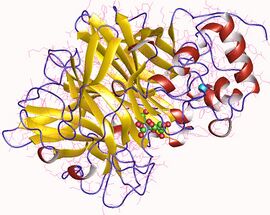Biology:Levansucrase
| levansucrase | |||||||||
|---|---|---|---|---|---|---|---|---|---|
 Levansucrase monomer, Bacillus subtilis | |||||||||
| Identifiers | |||||||||
| EC number | 2.4.1.10 | ||||||||
| CAS number | 9030-17-5 | ||||||||
| Databases | |||||||||
| IntEnz | IntEnz view | ||||||||
| BRENDA | BRENDA entry | ||||||||
| ExPASy | NiceZyme view | ||||||||
| KEGG | KEGG entry | ||||||||
| MetaCyc | metabolic pathway | ||||||||
| PRIAM | profile | ||||||||
| PDB structures | RCSB PDB PDBe PDBsum | ||||||||
| Gene Ontology | AmiGO / QuickGO | ||||||||
| |||||||||
Levansucrase (EC 2.4.1.10) is an enzyme that catalyzes the chemical reaction
- sucrose + (2,6-beta-D-fructosyl)n [math]\displaystyle{ \rightleftharpoons }[/math] glucose + (2,6-beta-D-fructosyl)n+1
Thus, the two substrates of this enzyme are sucrose and (2,6-beta-D-fructosyl)n, whereas its two products are glucose and (2,6-beta-D-fructosyl)n+1.
This enzyme belongs to the family of glycosyltransferases, specifically the hexosyltransferases. The systematic name of this enzyme class is sucrose:2,6-beta-D-fructan 6-beta-D-fructosyltransferase. Other names in common use include sucrose 6-fructosyltransferase, beta-2,6-fructosyltransferase, and beta-2,6-fructan:D-glucose 1-fructosyltransferase. This enzyme participates in starch and sucrose metabolism and two-component system - general.
Structural studies
As of late 2007, 3 structures have been solved for this class of enzymes, with PDB accession codes 1OYG, 1PT2, and 1W18.
References
- Hehre EJ (1951). "Enzymic Synthesis of Polysaccharides: A Biological type of Polymerization". Advances in Enzymology and Related Areas of Molecular Biology. Advances in Enzymology - and Related Areas of Molecular Biology. 11. 297–337. doi:10.1002/9780470122563.ch6. ISBN 978-0-470-12256-3.
- "The mechanism of polysaccharide production from sucrose. 3 Donor-acceptor specificity of levansucrase from Aerobacter levanicum". Biochem. J. 64 (2): 340–51. 1956. doi:10.1042/bj0640340. PMID 13363847.
- "Purification of levansucrase by precipitation with levan". Biochim. Biophys. Acta 113 (1): 79–83. 1966. doi:10.1016/s0926-6593(66)80123-6. PMID 5940635.
SacB counter-selection relies on the toxic product produced by the SacB gene. sacB comes from the gram-positive bacteria Bacillus subtilis and encodes the enzyme levansucrase that converts sucrose into a toxic metabolite in gram-negative bacteria. Plating on sucrose medium will select for cells that contain constructs that have lost the sacB gene.[1]
 |

